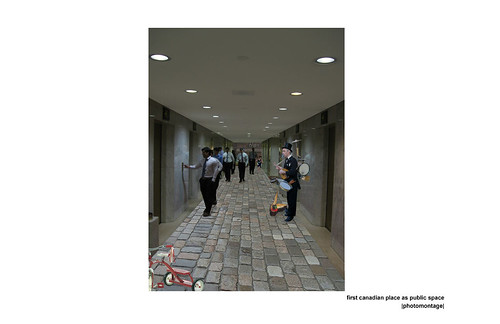
Spacing Magazine recently ran a competition called ThinkToronto in which young designers were asked to present their vision for some aspect of Toronto's future. Now that I know for absolutely sure that my design was not selected (the names were officially announced on Wednesday) I feel I can post it here.
The text interspersed with the images is the text that I submitted with the competition. In retrospect I realize that it probably sounds a bit radical. This is a different breed of project from those that actually won the competition, both in its criticality and in its lack of refinement.
All the images appear to be getting cut off - so if you're interested please click on them to see them in full.
** collage diagram showing current configuration
Healthy democracies derive their strength and flexibility from an active and dynamic public sphere. This kind of public sphere finds its clearest manifestation in the sort of public space that allows for free encounters and dialogue between citizens. This project entails a radical rethinking of the PATH system as a new subterranean network of public space, one that allows for collisions of difference – engagement between citizens from all segments of society, unfettered by the homogenizing pressures of consumerism.
This proposal creates a new zone in the city where people want to go, and can go year-round, not only to shop, but to be: to relax, to talk, to engage politically, to engage culturally, to perform and to spectate, to exercise their bodies, and to expand, focus, problematize, and engage their minds.
** diagram showing some possible programs that could be associated with the PATH
The current configuration of PATH is predicated upon and supports a limited and exclusionary vision of what it means to be human. The new PATH operates outside of this paradigm, inviting citizens to display openly their stories, traditions, habits and beliefs, and offering new possibilities for experiencing difference -- a key building block in constructing a tolerant, pluralistic society. Public space is about this sort of engagement. A redefinition of PATH would provide a massive infusion of viable public space, usable throughout the year, into the heart of downtown Toronto.
As a first step, the City of Toronto is required to expropriate a large portion of PATH. Although extensive, this expropriation is confined to the connective tissues that currently link the commercial enterprises. Not performing this acquisition would be equivalent to trying to plan a city in which not only the buildings but the sidewalks, the roads, and the parks were all owned by private companies. The expropriation is thus necessary in order to implement a comprehensive subterranean urban plan.
** Maps showing existing conditions and interventions
As primary nodes in this new subterranean urbanism, a handful of undergrade parks, or ‘unterparks’, are to be established. Three suitable candidates for this purpose are immediately apparent: the parking garage under Nathan Philips Square, the parking garage under Yonge-Dundas Square, and the ‘moat’ that lies between Union Station and the adjacent subway station. The future for which this PATH is envisioned is one without the need for cars in the downtown core. Unterparks are large, diverse zones including market-spaces, exercise spaces, skateboard parks, moss gardens, community pools, etc. In the cases of both the current parking lots deep incisions are necessary to allow natural light in. At Nathan Philips Square, for instance, the reflecting pool could become a waterfall with water streaming down into another pool below.
After the unterparks, a series of smaller public spaces are to be established, called ‘subsquares’. These are mainly repurposed from existing foodcourts, but are significantly redefined. Instead of fast food chains, affordable restaurants and cafés are encouraged with individual seating. Subsquares are places to meet, to rest, to enjoy the performance of a busker, or to have a picnic on the steps of a fountain.
The third element of expropriation is then to establish a clear network of underground boulevards, or ‘substreets’. The substreets will provide connections between the unterparks, the subsquares and the primary transit nodes. These are pedestrian promenades, both intended to channel commuters to and from their places of work, but also for people to generally enjoy walking along – to see and be seen, not like the Ramblas of Barcelona. The proposed substreets are considerably wider than most of the current corridors in PATH. Generally they are to be eight to twelve metres wide, allowing both for a generous thoroughfare for pedestrians and also room for street furniture on the side.
** Nathan Philip Square parking garage becomes a market, with perforations above to introduce light
Beyond these acts of expropriation, the remainder of the PATH shall continue to be privately owned, including all of the retail space off of the primary public areas. Generally, however, it is recommended that the current owners sell the retail units as condominium units, so that tenants may own the property instead of just renting. This will increase the diversity of shops and programme available in PATH.
Some simple strategies for increasing the likeliness of direct public encounter and dialogue include ‘graffiting walls’ and public stages and lecterns. Graffiting walls are chalk-board walls complete with chalk where people are encouraged to air their issues and grievances, in the manner of the medieval ‘talking statues’ of Rome or also in the manner of bathroom graffiti. The public stages and lecterns are to be used for speeches and public debates like ‘speaker’s corner’ in London but also they are to be used as stages for both impromptu and organized performances.
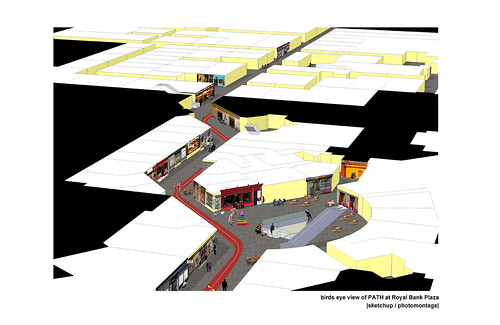
** Cut away perspective image demonstrating some potential moments from the proposed new PATH
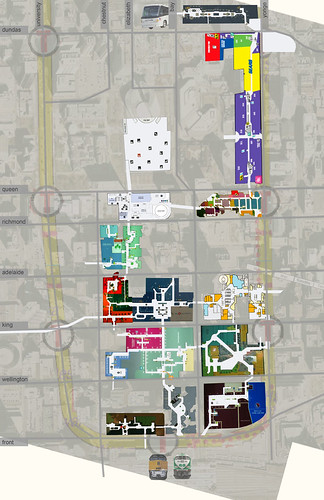
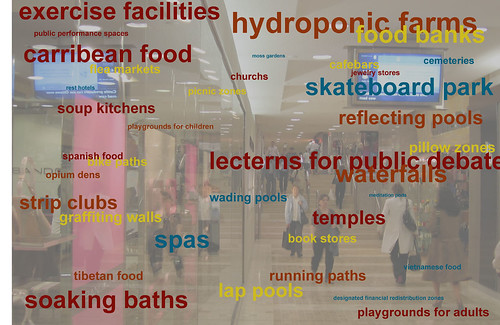
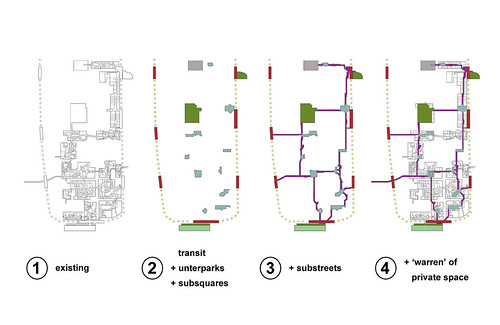
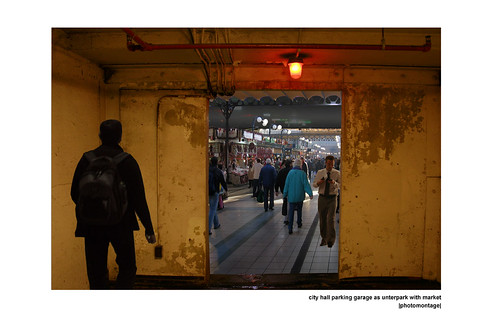

No comments:
Post a Comment